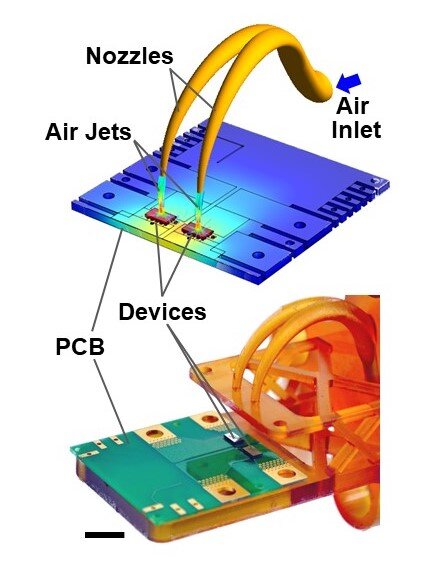
For decades, researchers have considered the potential for cooling hot electronic devices by blowing on them with high-speed air jets. However, air jet cooling systems are not widely used today. Two of the biggest obstacles that prevent the use of these systems is their complexity and weight. Air jet systems must be made of metal to be able to handle the pressure associated with air jets whose speed can exceed 200 miles per hour. And the air handling system can be complex with many discrete components that manage the air flow and direct the air onto the hot spots where cooling is required.
Now, researchers at the University of Illinois at Urbana-Champaign have demonstrated a new type of air jet cooler that overcomes previous barriers to jet cooling systems. Using additive manufacturing, the researchers created an air jet cooling system in a single component that can direct high-speed air onto multiple electronics hot spots. The researchers manufactured the cooling system from strong polymer materials that can withstand the harsh conditions associated with high-speed air jets.
"The design freedom of additive manufacturing allows us to create cooling solutions that have sizes and shapes not previously possible," said William King, Andersen Chair and Professor of Mechanical Science and Engineering. "This really opens up a new world of opportunities for thermal management."
The research focused on heat removal from high-power electronic devices. "The acute thermal management problems of high-power electronic devices appear in a host of applications, especially in modern data centers as well as electric vehicles including aircraft, automotive, and off-road vehicles," said Nenad Miljkovic, Associate Professor of Mechanical Science and Engineering at Illinois and co-author on the published research.
The applications of high-power electronic devices are growing rapidly—in electric cars, solar power systems, 5G communications, and high-power computing utilizing graphics processing units (GPU), to name a few. The electronic devices in these systems generate heat that must be removed in order for effective and reliable operation. In general, higher power results in higher performance. Unfortunately, higher power also makes it more difficult to remove the heat. New cooling technologies are required to support the growth of electric systems.
The paper, "Air Jet Impingement Cooling of Electronic Devices Using Additively Manufactured Nozzles," was published in the journal IEEE Transactions on Components, Packaging, and Manufacturing Technology.
More information: Beomjin Kwon et al. Air Jet Impingement Cooling of Electronic Devices Using Additively Manufactured Nozzles, IEEE Transactions on Components, Packaging and Manufacturing Technology (2019). DOI: 10.1109/TCPMT.2019.2936852
Citation: Researchers demonstrate new capability for cooling electronics (2020, February 18) retrieved 18 February 2020 from https://techxplore.com/news/2020-02-capability-cooling-electronics.html
This document is subject to copyright. Apart from any fair dealing for the purpose of private study or research, no part may be reproduced without the written permission. The content is provided for information purposes only.
